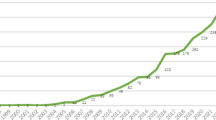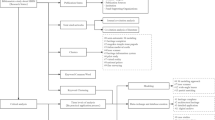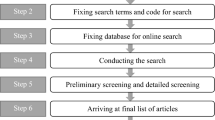Abstract
This study quantitatively investigated the scientific progress of walkability research landscape and its future prospects using bibliometric indicators to highlight the research hotspots. The results accentuated multifaceted nature of walkability research landscape with a strong association towards public health disciplines. Keyword co-occurrence analysis emphasized that majority of the walkability studies centred on the interactions between walking and other three main factors such as built environment attributes, transportation and obesity. Based on the identified research hotspots, a brief state-of-the-art review of walkability studies was presented. Future prospects based on the unexplored research gaps within the hotspots were also discussed. High correlation (r = 0.99, p < 0.05) between annual publications and citation counts demonstrated the significance of walkability studies to the contemporary scientific community. Being one of the comprehensive studies to evaluate the historic trajectory of walkability research landscape, the findings were expected to accelerate a comprehensive understanding of the walkability research domain that will assist future research direction.





Similar content being viewed by others
Data availability
The datasets used and/or analysed during the current study are available from the corresponding author on reasonable request.
References
Adams J (2005) Early citation counts correlate with accumulated impact. Scientometrics 63:567–581
Aghaabbasi M, Moeinaddini M, Shah MZ, Asadi-Shekari Z, Kermani MA (2018) Evaluating the capability of walkability audit tools for assessing sidewalks. Sustain Cities Soc 37:475–484
An XY, Wu QQ (2011) Co-word analysis of the trends in stem cells field based on subject heading weighting. Scientometrics 88(1):133–144
Andrews GJ, Hall E, Evans B, Colls R (2012) Moving beyond walkability: on the potential of health geography. Soc Sci Med 75:1925–1932
Booth GL, Creatore MI, Austin P, Luo J, Fazli GS, Moineddin R, Gozdyra P, Matheson F, Glazier R (2014) Neighborhood walkability and 10-year diabetes incidence among an urban cohort. Diabetes 63:A100–A101
Cerin E, Leslie E, du Toit L, Owen N, Frank LD (2007) Destinations that matter: associations with walking for transport. Health & Place 13(3):713–724
Cerin E, Zhang CJ, Barnett A, Sit CH, Cheung MM, Johnston JM, Lai PC, Lee RS (2016) Associations of objectively-assessed neighborhood characteristics with older adults’ total physical activity and sedentary time in an ultra-dense urban environment: findings from the ALECS study. Health & Place 42:1–10
Chuang KY, Huang YL, Ho YS (2007) A bibliometric and citation analysis of stroke-related research in Taiwan. Scientometrics 72(2):201–212
Du H, Wei L, Brown MA, Wang Y, Shi Z (2013) A bibliometric analysis of recent energy efficiency literatures: an expanding and shifting focus. Energy Efficiency 6:177–190
Duncan GE, Cash SW, Horn EE, Turkheimer E (2015) Quasi-causal associations of physical activity and neighborhood walkability with body mass index: a twin study. Prev Med 70:90–95
Falagas ME, Karavasiou AI, Bliziotis IA (2006) A bibliometric analysis of global trends of research productivity in tropical medicine. Acta Trop 99:155–159
Fazli GS, Rezai R, Bierman AS, Moineddin R, Booth GL (2017) The effects of ethnicity on the development of prediabetes among immigrant populations living in low vs high walkability areas: a population-based cohort study. Diabetologia 60:S103–S103
Ferenchak NN, Katirai M (2015) Commute mode and mental health in major metropolitan areas. Transportation Letters 7(2):92–103
Foster S, Knuiman M, Villanueva K, Wood L, Christian H, Giles-Corti B (2014) Does walkable neighbourhood design influence the association between objective crime and walking? Int J Behav Nutr Phys Act 11(1):100
Frank LD, Kerr J, Sallis JF, Miles R, Chapman J (2008) A hierarchy of sociodemographic and environmental correlates of walking and obesity. Prev Med 47(2):172–178
Friedenreich CM, Neilson HK, Farris MS, Courneya KS (2016) Physical activity and cancer outcomes: a precision medicine approach. Clin Cancer Res 22:4766–4775
Fu HZ, Wang MH, Ho YS (2013) Mapping of drinking water research: a bibliometric analysis of research output during 1992–2011. Sci Total Environ 443:757–765
Gase LN, Barragan NC, Simon PA, Jackson RJ, Kuo T (2015) Public awareness of and support for infrastructure changes designed to increase walking and biking in Los Angeles County. Prev Med 72:70–75
Guimpert I, Hurtubia R (2018) Measuring, understanding and modelling the walking neighborhood as a function of built environment and socioeconomic variables. J Transp Geogr 71:32–44
Habibian M, Hosseinzadeh A (2018) Walkability index across trip purposes. Sustain Cities Soc 42:216–225
Hajna S, Ross NA, Joseph L, Harper S, Dasgupta K (2016) Neighbourhood walkability and daily steps in adults with type 2 diabetes. PLoS One 11:15
Hinckson E, Cerin E, Mavoa S, Smith M, Badland H, Witten K, Kearns R, Schofield G (2017) What are the associations between neighbourhood walkability and sedentary time in New Zealand adults? The URBAN cross-sectional study. BMJ Open 7:9
Hsieh S, Klassen AC, Curriero FC, Caulfield LE, Cheskin LJ, Davis JN, Goran MI, Weigensberg MJ, Spruijt-Metz D (2014) Fast-food restaurants, park access, and insulin resistance among Hispanic youth. Am J Prev Med 46(4):378–387
James P, Kioumourtzoglou MA, Hart JE, Banay RE, Kloog I, Laden F (2017) Interrelationships between walkability, air pollution, greenness, and body mass index. Epidemiology 28:780–788
Jia Y, Usagawa T, Fu H (2014) The association between walking and perceived environment in Chinese community residents: a cross-sectional study. PLoS One 9(2):e90078
Jia XJ, Yu Y, Xia WN, Masri S, Sami M, Hu ZX, Yu ZX, Wu J (2018) Cardiovascular diseases in middle aged and older adults in China: the joint effects and mediation of different types of physical exercise and neighborhood greenness and walkability. Environ Res 167:175–183
Knuiman MW, Christian HE, Divitini ML, Foster SA, Bull FC, Badland HM, Giles-Corti B (2014) A longitudinal analysis of the influence of the neighborhood built environment on walking for transportation: the RESIDE study. Am J Epidemiol 180(5):F453–F461
Kolbe-Alexander TL, Pacheco K, Tomaz SA, Karpul D, Lambert EV (2015) The relationship between the built environment and habitual levels of physical activity in south African older adults: a pilot study. BMC Public Health 15(1):518
Kowaleski-Jones L, Brown BB, Fan JX, Hanson HA, Smith KR, Zick CD (2017) The joint effects of family risk of obesity and neighborhood environment on obesity among women. Soc Sci Med 195:17–24
Kushi LH, Doyle C, McCullough M, Rock CL, Demark-Wahnefried W, Bandera EV, McCullough M, Gansler T, Andrews KS, Thun MJ (2012) American Cancer Society guidelines on nutrition and physical activity for cancer prevention: reducing the risk of cancer with healthy food choices and physical activity. CA Cancer J Clin 62:30–67
Lee JS, Zegras PC, Ben-Joseph E (2013) Safely active mobility for urban baby boomers: the role of neighborhood design. Accid Anal Prev 61:153–166
Li Z, Ho YS (2008) Use of citation per publication as an indicator to evaluate contingent valuation research. Scientometrics 75(1):97–110
Li F, Harmer P, Cardinal BJ, Bosworth M, Johnson-Shelton D, Moore JM, Acock A, Vongjaturapat N (2009) Built environment and 1-year change in weight and waist circumference in middle-aged and older adults: Portland neighborhood environment and health study. Am J Epidemiol 169(4):401–408
Liu H, Yu Z, Chen C, Hong R, Jin K, Yang C (2018) Visualization and bibliometric analysis of research trends on human fatigue assessment. J Med Syst 42:179
Longo A, Hutchinson WG, Hunter RF, Tully MA, Kee F (2015) Demand response to improved walking infrastructure: a study into the economics of walking and health behaviour change. Soc Sci Med 143:107–116
Loo CKJ, Greiver M, Aliarzadeh B, Lewis D (2017) Association between neighbourhood walkability and metabolic risk factors influenced by physical activity: a cross-sectional study of adults in Toronto, Canada. BMJ Open 7:10
Lu Y, Sarkar C, Xiao Y (2018) The effect of street-level greenery on walking behavior: evidence from Hong Kong. Soc Sci Med 208:41–49
Maizlish N, Woodcock J, Co S, Ostro B, Fanai A, Fairley D (2013) Health cobenefits and transportation-related reductions in greenhouse gas emissions in the San Francisco Bay area. Am J Public Health 103:703–709
Mao G, Liu X, Du H, Zuo J, Wang L (2015) Way forward for alternative energy research: a bibliometric analysis during 1994–2013. Renew Sust Energ Rev 48:276–286
Mao G, Huang N, Chen L, Wang H (2018) Research on biomass energy and environment from the past to the future: a bibliometric analysis. Sci Total Environ 635:1081–1090
Marisamynathan S, Lakshmi S (2018) Method to determine pedestrian level of service for sidewalks in Indian context. Transportation Letters 10(5):294–301
Marshall JD, Brauer M, Frank LD (2009) Healthy neighborhoods: walkability and air pollution. Environ Health Perspect 117:1752–1759
Mateo-Babiano I (2016) Pedestrian’s needs matter: examining Manila’s walking environment. Transp Policy 45:107–115
Mayne DJ, Morgan GG, Jalaludin BB, Bauman AE (2018) Does walkability contribute to geographic variation in psychosocial distress? A spatial analysis of 91,142 members of the 45 and up study in Sydney, Australia. Int J Environ Res Public Health 15:24
Mazumdar S, Learnihan V, Cochrane T, Phung H, O’Connor B, Davey R (2016) Is walk score associated with hospital admissions from chronic diseases? Evidence from a cross-sectional study in a high socioeconomic status Australian city-state. BMJ Open 6:012548
McCormack GR, Friedenreich C, Sandalack BA, Giles-Corti B, Doyle-Baker PK, Shiell A (2012) The relationship between cluster-analysis derived walkability and local recreational and transportation walking among Canadian adults. Health & Place 18(5):1079–1087
Méline J, Chaix B, Pannier B, Ogedegbe G, Trasande L, Athens J, Duncan DT (2017) Neighborhood walk score and selected cardiometabolic factors in the French RECORD cohort study. BMC Public Health 17:960
Michael YL, Gold R, Perrin N, Hillier TA (2013) Built environment and change in body mass index in older women. Health & Place 22:7–10
Nagaratnam S, Ale Ebrahim N, Habibullah MS (2016) A bibliometric analysis on ‘fertility rate’ research trends. International Journal of Professional Business Review 1:1–14
Nelson NM, Woods CB (2010) Neighborhood perceptions and active commuting to school among adolescent boys and girls. J Phys Act Health 7(2):257–266
Pivo G, Fisher JD (2011) The walkability premium in commercial real estate investments. Real Estate Econ 39:185–219
Prajapati M, Advani M, Parida P (2018) Identifying the most suitable road crossing infrastructure based on estimated delay to pedestrians and vehicle users. Transportation Letters 10(2):113–127
Qin B, Han SS (2013) Planning parameters and household carbon emission: evidence from high-and low-carbon neighborhoods in Beijing. Habitat International 37:52–60
Rundle A, Neckerman KM, Freeman L, Lovasi GS, Purciel M, Quinn J, Richards C, Sircar N, Weiss C (2008) Neighborhood food environment and walkability predict obesity in new York City. Environ Health Perspect 117(3):442–447
Simons E, Dell SD, Moineddin R, To T (2018) Associations between neighborhood walkability and incident and ongoing asthma in children. Annals of the American Thoracic Society 15:728–734
Sugiyama T, Cerin E, Owen N, Oyeyemi AL, Conway TL, Van Dyck D, Schipperijn J, Macfarlane DJ, Salvo D, Reis RS, Mitáš J (2014) Perceived neighbourhood environmental attributes associated with adults′ recreational walking: IPEN adult study in 12 countries. Health & Place 28:22–30
Sun B, Yan H, Zhang T (2017) Built environmental impacts on individual mode choice and BMI: evidence from China. J Transp Geogr 63:11–21
Sundquist K, Eriksson U, Mezuk B, Ohlsson H (2015) Neighborhood walkability, deprivation and incidence of type 2 diabetes: a population-based study on 512,061 Swedish adults. Health & Place 31:24–30
Tarlov E, Zenk S, Matthews S, Wing C, Slater S, Xiang A, Tong H, Powell L (2017) The effect of neighborhood walkability on BMI, a retrospective longitudinal study of 1.7 million military veterans. Ann Behav Med 51:S2692–S2693
Van Dyck D, Cardon G, Deforche B, Owen N, De Bourdeaudhuij I (2011) Relationships between neighborhood walkability and adults’ physical activity: how important is residential self-selection? Health & Place 17:1011–1014
Van Holle V, Van Cauwenberg J, Deforche B, Van De Weghe N, De Bourdeaudhuij I, Van Dyck D (2015) Do psychosocial factors moderate the association between objective neighborhood walkability and older adults’ physical activity? Health & Place 34:118–125
Villanueva K, Knuiman M, Nathan A, Giles-Corti B, Christian H, Foster S, Bull F (2014) The impact of neighborhood walkability on walking: does it differ across adult life stage and does neighborhood buffer size matter? Health & Place 25:43–46
Wang Q, Yang Z, Yang Y, Long C, Li H (2014) A bibliometric analysis of research on the risk of engineering nanomaterials during 1999–2012. Sci Total Environ 473:483–489
Wasfi RA, Dasgupta K, Orpana H, Ross NA (2016) Neighborhood walkability and body mass index trajectories: longitudinal study of Canadians. Am J Public Health 106:934–940
Watson KB, Carlson SA, Humbert-Rico T, Carroll DD, Fulton JE (2015) Walking for transportation: what do US adults think is a reasonable distance and time? J Phys Act Health 12(6 Suppl 1):S53–S61
Wen M, Kowaleski-Jones L (2012) The built environment and risk of obesity in the United States: racial–ethnic disparities. Health & Place 18(6):1314–1322
Wu Z, Ren Y (2018) A bibliometric review of past trends and future prospects in urban heat island research from 1990 to 2017. Environ Rev 27(2):241–251
Xie S, Zhang J, Ho YS (2008) Assessment of world aerosol research trends by bibliometric analysis. Scientometrics 77(1):113–130
Yeung AWK, Mocan A, Atanasov AG (2018) Let food be thy medicine and medicine be thy food: a bibliometric analysis of the most cited papers focusing on nutraceuticals and functional foods. Food Chem 269:455–465
Yum S (2019) The effect of soft variables on travel mode choices. Transportation Letters:1–12
Zhang M, Gao M, Yue S, Zheng T, Gao Z, Ma X, Wang Q (2018) Global trends and future prospects of food waste research: a bibliometric analysis. Environ Sci Pollut Res 25(25):24600–24610
Zhang L, Geng Y, Zhong Y, Dong H, Liu Z (2019) A bibliometric analysis on waste electrical and electronic equipment research. Environ Sci Pollut Res:1–11
Zhao L, Deng J, Sun P, Liu J, Ji Y, Nakada N, Qiao Z, Tanaka H, Yang Y (2018) Nanomaterials for treating emerging contaminants in water by adsorption and photocatalysis: systematic review and bibliometric analysis. Sci Total Environ 627:1253–1263
Funding
The authors gratefully acknowledge the financial support from University of Malaysia Living Lab Research Grant (LL038-18SUS) and University of Malaya Partnership Grant (RK003–2017) for this study.
Author information
Authors and Affiliations
Contributions
Logaraj Ramakreshnan: Conceptualization, methodology, investigation, preparation of original draft, review and editing. Chng Saun Fong: Conceptualization, methodology, investigation and review. Nik Meriam Sulaiman: Conceptualization, methodology and review. Nasrin Aghamohammadi: Funding acquisition, conceptualization, methodology, writing, review and supervision.
Corresponding author
Ethics declarations
Competing interests
The authors declare that they have no competing interests.
Additional information
Responsible Editor: Philippe Garrigues
Publisher’s note
Springer Nature remains neutral with regard to jurisdictional claims in published maps and institutional affiliations.
Rights and permissions
About this article
Cite this article
Ramakreshnan, L., Aghamohammadi, N., Fong, C.S. et al. A comprehensive bibliometrics of ‘walkability’ research landscape: visualization of the scientific progress and future prospects. Environ Sci Pollut Res 28, 1357–1369 (2021). https://doi.org/10.1007/s11356-020-11305-x
Received:
Accepted:
Published:
Issue Date:
DOI: https://doi.org/10.1007/s11356-020-11305-x




